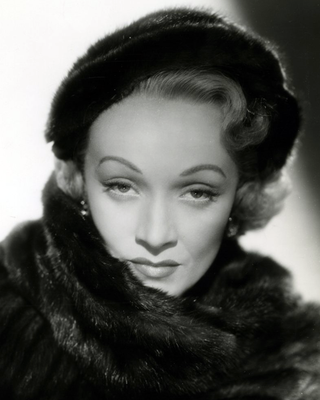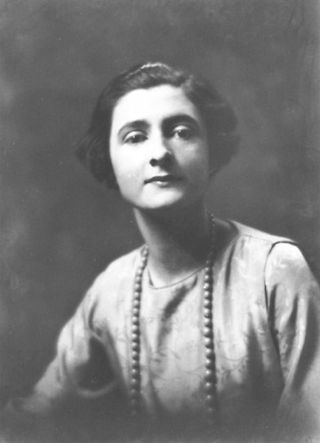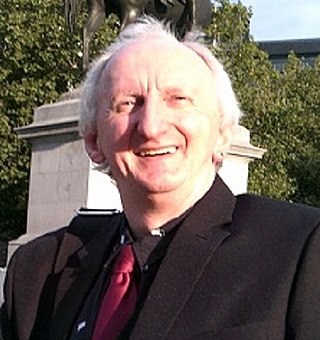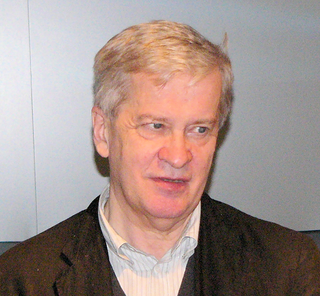
Greta Garbo was a Swedish-American actress. Regarded as one of the greatest screen actresses of all time, she was known for her melancholic, somber persona, her film portrayals of tragic characters, and her subtle and understated performances. In 1999, the American Film Institute ranked Garbo fifth on its list of the greatest female stars of classic Hollywood cinema.

Marie Magdalene "Marlene" Dietrich was a German and American actress and singer whose career spanned from the 1910s to the 1980s.

Mercedes de Acosta was an American poet, playwright, and novelist. Although she failed to achieve artistic and professional distinction, de Acosta is known for her many lesbian affairs with celebrated Broadway and Hollywood personalities including Alla Nazimova, Isadora Duncan, Eva Le Gallienne, and Marlene Dietrich. Her best-known involvement was with Greta Garbo with whom, in 1931, she began a sporadic and volatile romance. Her 1960 memoir, Here Lies the Heart, is considered part of gay history insofar that it hints at the lesbian element in some of her relationships.
"New Queer Cinema" is a term first coined by the academic B. Ruby Rich in Sight & Sound magazine in 1992 to define and describe a movement in queer-themed independent filmmaking in the early 1990s.

Laura Mulvey is a British feminist film theorist. She was educated at St Hilda's College, Oxford. She is currently professor of film and media studies at Birkbeck, University of London. She previously taught at Bulmershe College, the London College of Printing, the University of East Anglia, and the British Film Institute.

David Bret is a British author of show business biographies. He chiefly writes on the private life of film stars and singers.

Jean O'Leary was an American lesbian and gay rights activist. She was the founder of Lesbian Feminist Liberation, one of the first lesbian activist groups in the women's movement, and an early member and co-director of the National Gay and Lesbian Task Force. She co-founded National Coming Out Day.

B. Ruby Rich is an American scholar; critic of independent, Latin American, documentary, feminist, and queer films; and a professor emerita of Film & Digital Media and Social Documentation at UC Santa Cruz. Among her many contributions, she is known for coining the term "New Queer Cinema". She is currently the editor of Film Quarterly, a scholarly film journal published by University of California Press.
Rose Troche is an American film and television director, television producer, and screenwriter.

Richard Dyer is an English academic who held a professorship in the Department of Film Studies at King's College London. Specialising in cinema, queer theory, and the relationship between entertainment and representations of race, sexuality, and gender, he was previously a faculty member of the Film Studies Department at the University of Warwick for many years and has held a number of visiting professorships in the United Kingdom, the United States, Italy, Sweden, Denmark, and Germany.
Mary Wings is an active American cartoonist, writer, and artist. She is known for highlighting lesbian themes in her work. In 1973, she made history by releasing Come Out Comix, the first lesbian comic book. She is also known for her series of detective novels featuring lesbian heroine Emma Victor. Divine Victim, Wings' only Gothic novel, won the Lambda Literary Award for Lesbian Mystery in 1994.

Marlene Dietrich was a German and American actress and singer.
Queer pornography depicts performers with various gender identities and sexual orientations interacting and exploring genres of desire and pleasure in unique ways. These conveyed interactions distinctively seek to challenge the conventional modes of portraying and experiencing sexually explicit content. Scholar Ingrid Ryberg additionally includes two main objectives of queer pornography in her definition as "interrogating and troubling gender and sexual categories and aiming at sexual arousal."
Since the transition into the modern-day gay rights movement, homosexuality has appeared more frequently in American film and cinema.

The Girls: Sappho Goes To Hollywood is a 2000 book by Diana McLellan that speculates on a romance between Greta Garbo and Marlene Dietrich. The Observer found it "purely speculative" and "uncorroborated". Kirkus found it "lively". Publishers Weekly was more approving, saying McLellan was able to "bring a broader context and new sense of scholarship to the subject". The Houston Chronicle praised "exhaustive" research and found the book far from salacious.

The Melbourne Queer Film Festival is an annual LGBT film festival held in Melbourne, Victoria, Australia. Held in November, the festival is regarded as the largest queer film event in the Southern Hemisphere. The festival attracts around 23,000 attendees at key locations around Melbourne.
Queer art, also known as LGBT+ art or queer aesthetics, broadly refers to modern and contemporary visual art practices that draw on lesbian, gay, bisexual, transgender, and various non-heterosexual, non-cisgender imagery and issues. While by definition there can be no singular "queer art", contemporary artists who identify their practices as queer often call upon "utopian and dystopian alternatives to the ordinary, adopt outlaw stances, embrace criminality and opacity, and forge unprecedented kinships and relationships." Queer art is also occasionally very much about sex and the embracing of unauthorised desires.











